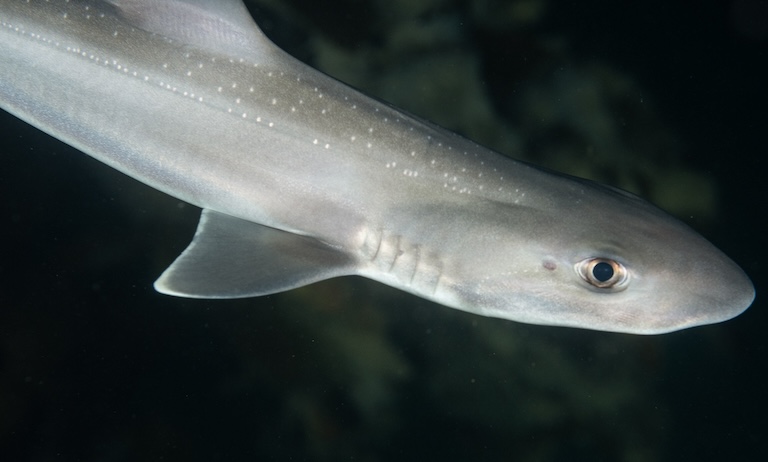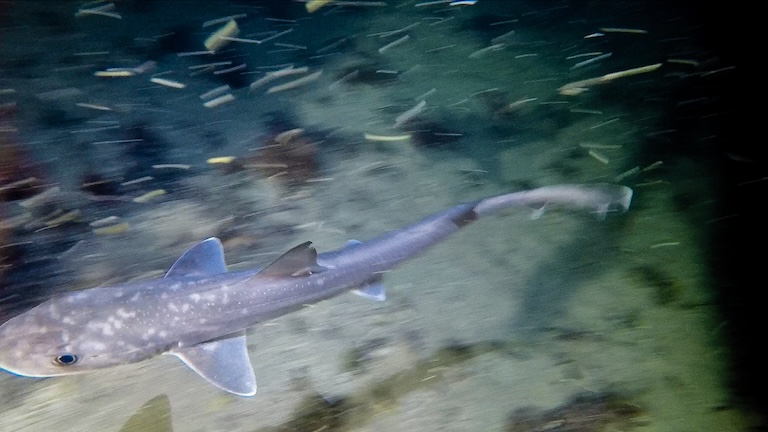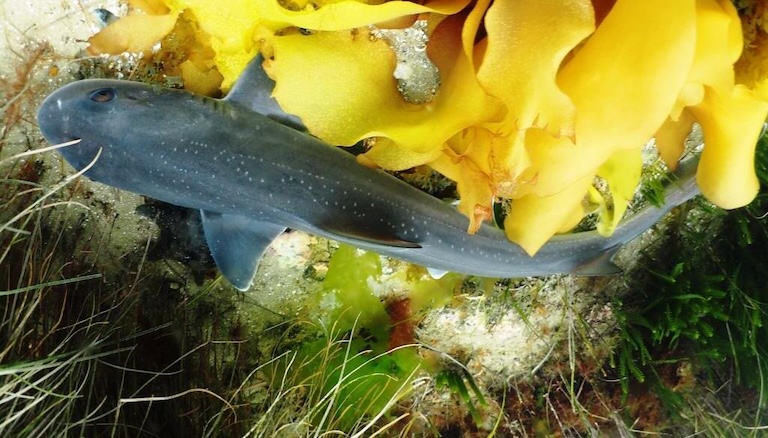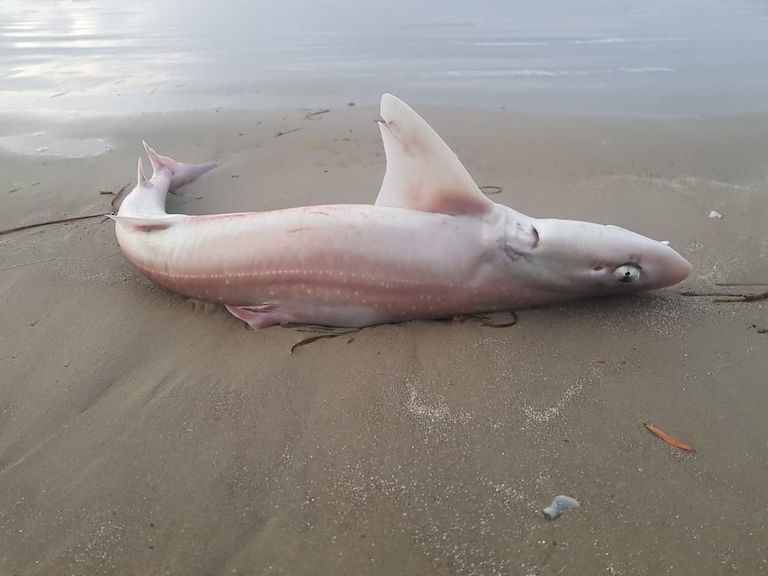Gummy Shark Profile
If you’ve been following this blog at all, you’re probably familiar with the borderline-creepy appreciation of requiem sharks. Honestly, if sharks had an HR team, we’d probably be up for mediation for being too overt with the compliments. They’re just so hot.
But this isn’t a dog-whistle to the furry (scaly?) community, it’s an honest, platonic appreciation for an animal that is just so awesome to look at you can’t help but question your principles.
Like the effect that Jason Momoa and Natasha Lyonne have on people who thought they were straight. Requiem sharks are just a good-looking order, but like all such orders, they do have their runty, plain-lookin’, possibly adopted siblings that would never make it into A Minecraft Movie.
Today’s fish, with a face for radio, is a good example of this. Introducing: the gummy shark (doo doo doodoo doodoo).

Gummy Shark Facts Overview
| Habitat: | Coastal marine |
| Location: | Southern Australia |
| Lifespan: | Around 16 years |
| Size: | 185cm (73 in) |
| Weight: | Up to around 25 kg (55 lb) |
| Colour: | Grey, lighter belly |
| Diet: | Crustaceans, marine worms, small fish, and cephalopods |
| Predators: | Larger sharks, humans |
| Top Speed: | Not listed |
| No. of Species: | 1 |
| Conservation Status: | Least Concern |
Gummy sharks are slender, runty-looking Requiem sharks, who lay eggs inside themselves, eat one another and then breed a lot of pups that come out specialised in crustacean crushing.
These sharks are perhaps not as zesty and sugar coated as their name would suggest, but they do appear to be a popular source of food for locals.
Despite this, their strong breeding strategies and attentive fishing regulations mean they’re still doing quite well.
Interesting Gummy Shark Facts
1. They’re Requiem sharks (for now)
Gummy Sharks may be the voice actors of the Requiem order, but they are nonetheless members. At least, they are currently – the order is flagged for review on account of some of the species perhaps not as related as others.
This might result in a reshuffling, and the two families under the spotlight, in particular, are Scyliorhinidae, the catsharks, and Triakidae, the family of so-called houndsharks, which includes the gummy shark.
But, looking closer at these accusations, it appears the family is let down by two unrelated species from two separate genera than the gummy sharks’. Unfortunately, this is about the extent to which attention spans can be granted to taxonomy, so researchers have concluded it here as unresolved. 1

2. They’re slim
The gummy shark genus, Mustelus, might be familiar to fans of the mammalian mesopredatory monsters known as Mustelids, and this isn’t a coincidence.
There are around 28 recognised species in this genus and they’re named for being weasel-like. Commonly known as smoothhounds, they are neither weasels nor dogs, but they are smooth: a group of very slender and sleek, small-to-medium sharks with short heads.
Their stats reflect just how skinny they are – while they can grow up to nearly two metres long, they weigh no more than about 25 kilos, making them very light for their length, and giving them, perhaps, a weasel-like quality. 2
3. They’re separated by sex
Possibly as a way to avoid cannibalism lots of other species of shark gather in groups based on size. This means that large aggregations of this species are typically around the same age.
But the other common way sharks segregate themselves is by sex, and gummy sharks choose this method overall.
Males and females are typically found in different locations and females are also found more predominantly at deeper depths than males.
4. They’re ovoviviparous
Reproductive terms can get a bit confusing and are a bit of a niche interest, so it’s sometimes better to keep things simple.
This is why “gives birth to live young” is usually enough. But for those who like to understand in a bit more detail why how these live y9oung come about, and why other sharks lay eggs, it’s worth covering the basic strategies.
Humans are placental mammals, named after that weird organ that women grow just for their babies and then occasionally cook and eat afterwards for some reason. As placentals, we differ quite a bit from the monotremes, who are a small group of primitive mammals that still lay eggs.
Both groups have eggs, but the monotremes push those out of them before they develop, in a strategy known as oviparity. Holding the egg inside to develop into a functional animal before pushing it out of the appropriate hole is called viviparity.
Some sharks lay eggs, like the dogfishes, others give birth to live young. Of the second group, some are viviparous, growing a placenta to feed the young inside the mother, like most mammals.
Others, like the gummy shark and Ovoviviparous, meaning they lay eggs, but they do it into a special chamber inside themselves, and the eggs sit there developing inside the shells, inside the mother.
With no placenta in ovoviviparous sharks, the young feed almost entirely on the egg yolk (yolks are another lengthy but interesting dimension to all of this), and sometimes on the egg shells and on one another, before they’re ready to be birthed.
So, the gummy sharks begin life as eggs, growing inside their mothers. Then, they battle for survival, embryo-eating-embryo, until they are spuffed out into the open ocean to go it alone. 3

5. A lot of them make it
Despite the in-utero battle-royale nature of their beginnings, these sharks are survivors. By 4-5 years old they’re sexually mature and ready to pit their own unborn babies against one another, and a remarkable number of them come out alive.
Litters take around a year to pop out and are usually around 14 pups, but some can be up to 57. That’s a lot of gummy sharks, but at the rate they’re fished, it seems necessary.
6. They’re fished a lot
This is a common catch among fisheries and one that’s regulated by weight in quotas.
That traditionally means, when they’re brought up in gillnets, if there’s already been a certain tonnage of them recorded, they are thrown back into the ocean dead instead of brought to shore, because somehow that’s supposed to protect the species.
But the obvious flaws in this approach are slowly being addressed in some species, especially where they are being unsustainably killed. In some places, bycatch is now required to be brought ashore for record-keeping, but for the gummy shark, this isn’t thought to be necessary yet.
This species is said to be stable and of Least Concern thanks in part to some decent fishing regulations around Australian coasts. 4

Gummy Shark Fact-File Summary
Scientific Classification
| Kingdom: | Animalia |
| Phylum: | Chordata |
| Class: | Chondrichthyes |
| Order: | Carcharhiniforms |
| Family: | Triakidae |
| Genus: | Mustelus |
| Species: | antarcticus |
Fact Sources & References
- Ximena Vélez-Zuazo (2010), “Shark tales: A molecular species-level phylogeny of sharks (Selachimorpha, Chondrichthyes)”, Sci Hub.
- “Gummy shark”, Australian Government.
- Jennifer Kennedy (2019), “Ovoviviparous Animals”, Thought Co.
- “Gummy Shark”, IUCN Red List.
